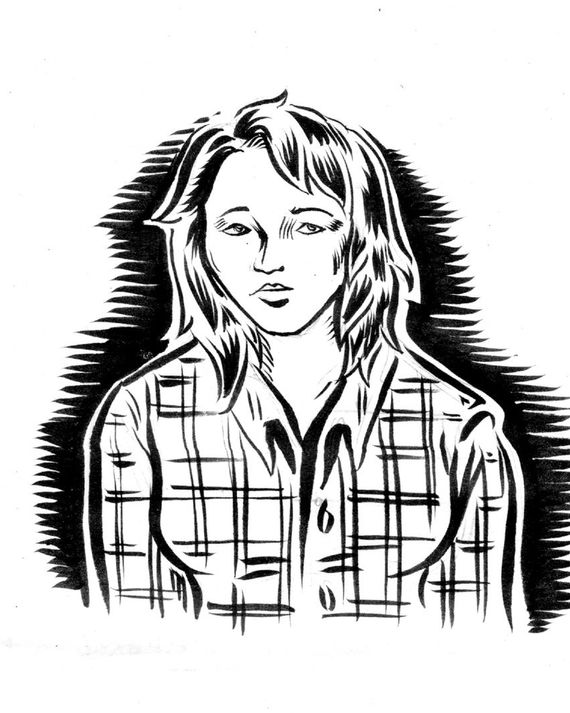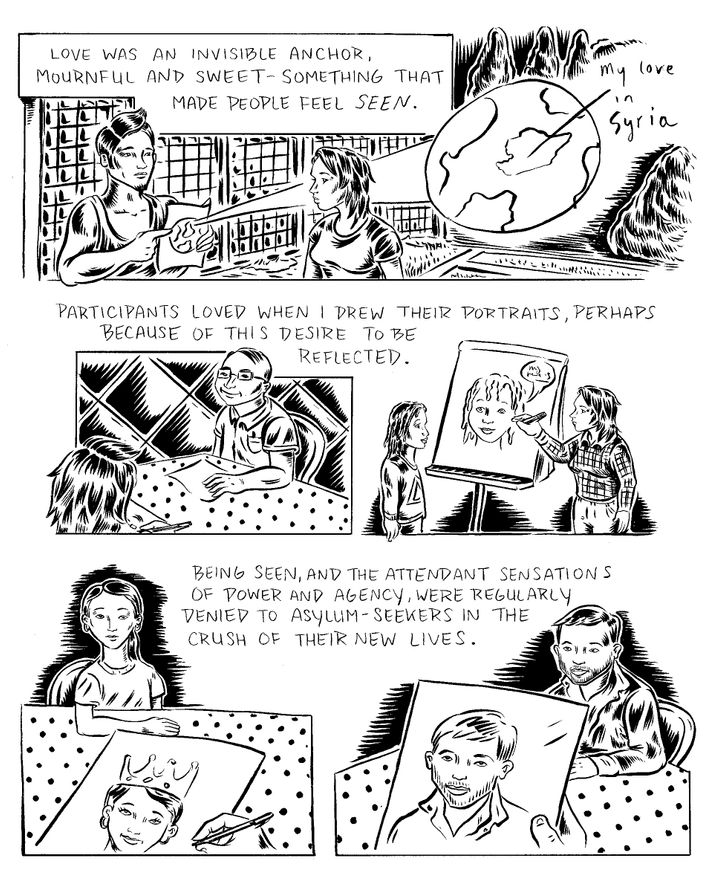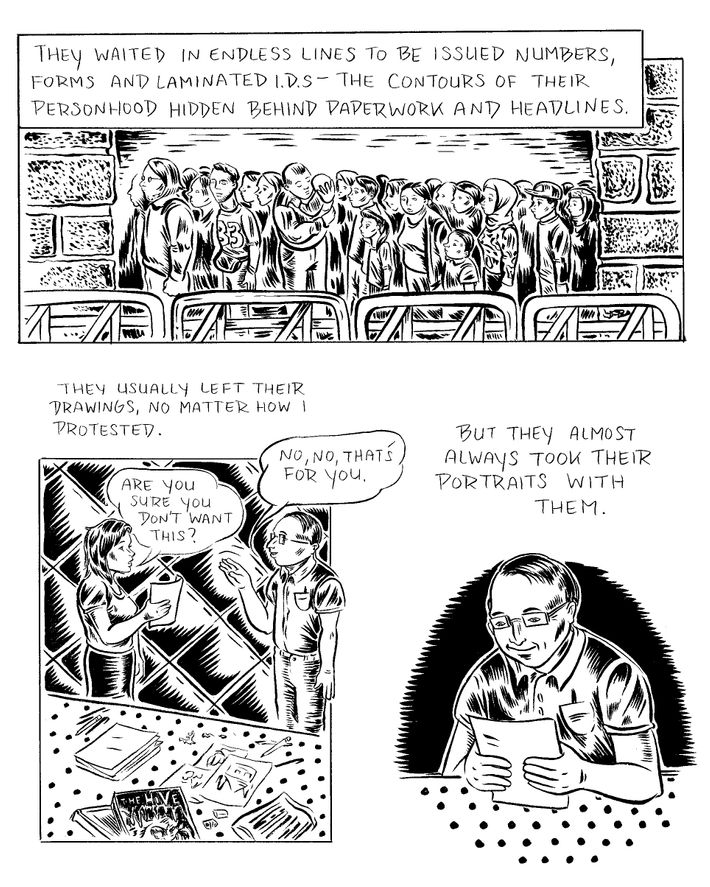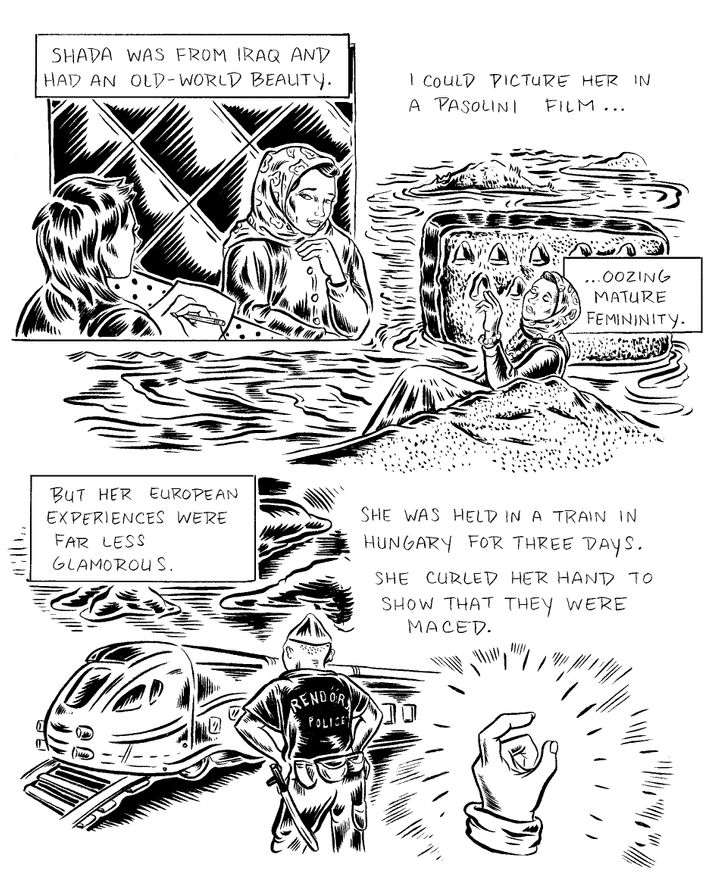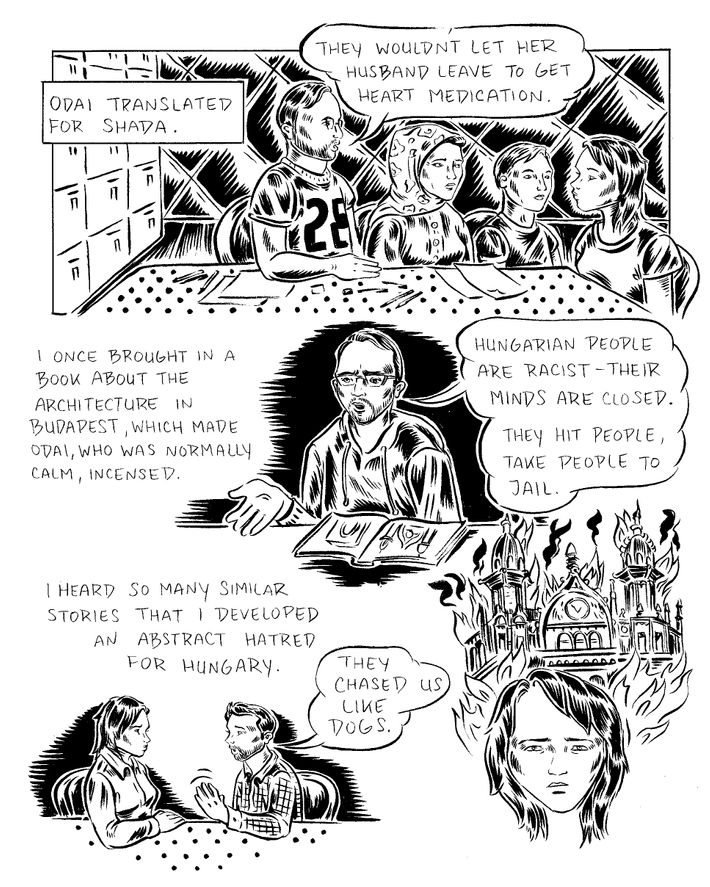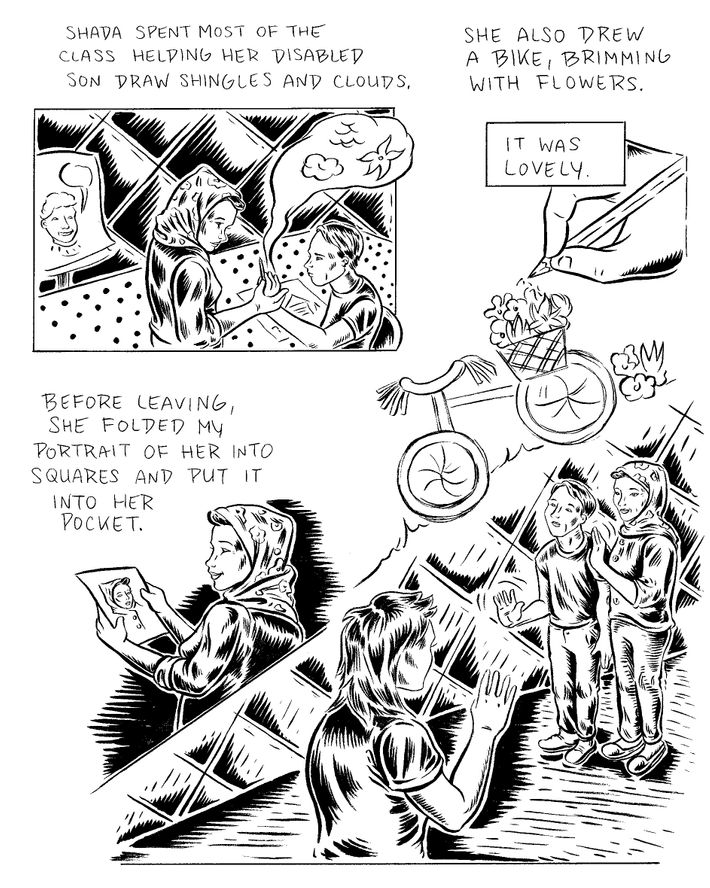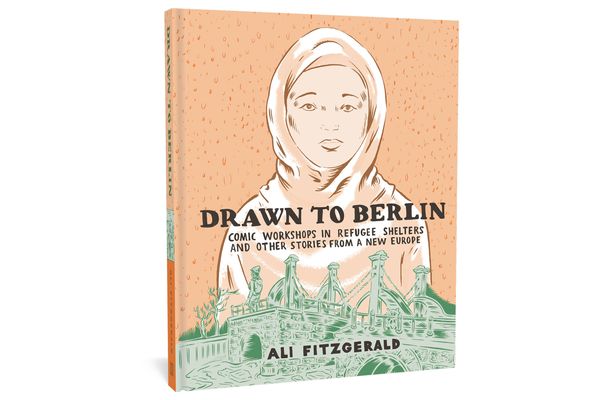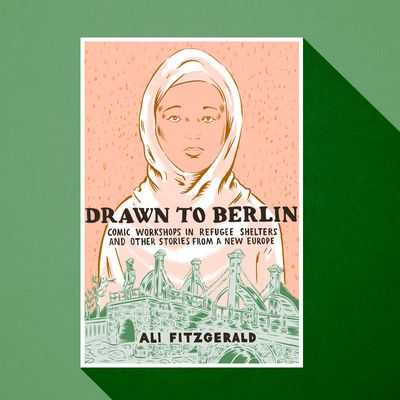
Berlin-based artist Ali Fitzgerald is perhaps best known for making sharp comic foils out of animals like Hungover Bear and the mythical creatures who populate the CutÔÇÖs ÔÇ£Bermuda Square.ÔÇØ But her new book, Drawn to Berlin (Fantagraphics), centers on refugees in a Berlin shelter where Fitzgerald taught art for more than a year. (See below for an exclusive five-page excerpt.) She tells their stories (and her own) through stunning, sobering imagery that straddles the line between real and surreal. As her students try to find their footing, GermanyÔÇÖs frightening tribalist movement rises to meet them. Over beers at BrooklynÔÇÖs Pacific Standard, Fitzgerald and I talked about the rules she wrote for herself, how sheÔÇÖd change the bookÔÇÖs ending, and why she needs to find a new dentist.
Drawn to Berlin doesnÔÇÖt remind me of any other books. Did you have any templates in mind as you were writing it?
I didnÔÇÖt actually have a ÔÇö in German you would say a forbilt. I donÔÇÖt usually think in German, but thatÔÇÖs a good word. There are people I like, for example Joe Sacco. But his stuff is quite different, more like comic journalism. I knew that this story was very specific and I wanted to tell it in a specific way, and there actually werenÔÇÖt any models I could think of. There were just people that I thought about as I was doing it; Joe Sacco was one of them, Alison Bechdel was another. Maybe a couple others.
So you went in blind.
I did, which was kind of scary. And I didnÔÇÖt show anyone the book until it was done, except my editor at Fantagraphics, Kristy Valenti.
Did you have any reservations about telling your studentsÔÇÖ stories?
The idea of it is a little bit fraught, or at least very complex. There were some things about the complexity of trauma that I didnÔÇÖt understand in the beginning. Those became a bit clearer to me as I went along. I wanted to include the ethical struggle in the book because I think itÔÇÖs important to have that conversation. I made rules for myself about not sensationalizing people or their stories. With the two main characters, I was kind of checking in a bit. And then a few other rules made it okay for me. I think itÔÇÖs a conversation a lot of people are having right now. Nonfiction comics are kind of a Wild West territory. Comic journalism hasnÔÇÖt existed for very long ÔÇö I wouldnÔÇÖt call this comic journalism, but there are elements of that. How you depict people and how much you can invent and the rules of quoting ÔÇö all that stuff is still being written. ThatÔÇÖs what makes it exciting, but also complicated and messy and scary.
Early on, you would show them a picture of a ship and ask them to draw what was under the ship. That proved to be a trigger for some students, who had lost loved ones at sea on their journey to Germany.
ThatÔÇÖs a good example of how we come to things differently and how we can be so oblivious. ThatÔÇÖs a very specific kind of trauma that I didnÔÇÖt have access to. I should say that a lot of people did delve into the fantasy aspect of the sea, but there were people for whom the associations were really clear and painful.
What do your students think of the book?
Before I left, I gave copies to the two main characters, Saker and Michael. They both like it, but they didnÔÇÖt want their real names to be there. When youÔÇÖre applying for a job or something, you donÔÇÖt necessarily want the person to know that youÔÇÖve been in a refugee shelter.
What was the hardest part of the writing process?
There were a couple formal, physical things that were really hard. I was a bit I dont want to say arrogant, but going into the process I felt quite confident in terms of my ability to draw. I had been doing Hungover Bear for a while. I had been doing a weekly or biweekly comic for three years, and fast. So I set a certain pace for myself, but I couldnt meet it. Some days I would draw for ten hours, and I still couldnt keep up. When youre portraying real people, its important to be sensitive. There also has to be a lot of continuity in a longer piece. And the writing was super tough, too, because I was thinking about what to include, what not to include. What is sensational? And again I had certain rules, like I didnt want to draw the war in Syria, for instance. The only passage set in Syria is about a chocolate factory. The process of editing was also really difficult.
So the hardest part was the drawing  and the writing  and the editing.
Yeah. The inking was okay. The inking was my favorite part.
Drawn to Berlin feels so much bigger than your other series.
ItÔÇÖs interesting that you say ÔÇ£bigger,ÔÇØ because I actually drew them so much bigger than itÔÇÖs printed. The original pages were 11-by-17. ThatÔÇÖs also part of the reason it took a long time. To draw and ink one of those pages would take around six hours. I actually want to do a Hungover Bear book at some point. It would be a longer narrative: Hungover Bear in the Cave of Love. But I havenÔÇÖt found time to write it yet.
How long did you spend working on this book?
About a year full-time, and I taught the workshops for a year and a half, so the whole thing took a long time: two-and-a-half years. The ending I did a bit later than the rest of the book because I included something that happened in 2017.
Was it originally more of a downer ending?
It was just more of an abrupt ending. If I wrote the book now, though, itÔÇÖd be a less hopeful ending. I think the ending is overly hopeful.
Because of whatÔÇÖs happened since then?
Yeah. Over the last year, Germany has had this really ascendant tribalism, the same as here in the U.S. ItÔÇÖs really intense, and there were recently violent protests in Chemnitz. ItÔÇÖs really getting mainstream. I feel like the ending of the book portrays Germany as sort of a bulwark against this kind of right-wing nativism. ItÔÇÖs in the book; it was already happening. But I was hopeful that Germany was going to swerve away from this. Now I feel less optimistic.
Last month a poll showed that the far-right party Alternative for Germany (AFD) was the second-most popular party in Germany. And in certain parts of East Germany, theyÔÇÖre in power and theyÔÇÖre the number-one party. ThatÔÇÖs where these protests take place and where some refugee shelters have been burned. I didnÔÇÖt include this in the book, but West Germany and East Germany have different educational systems. West Germany was taught to confront Nazism and its past, and they use the collective pronoun ÔÇ£WeÔÇØ in talking about what the Nazis did. But East German schools taught that Nazism was something that West Germans had done. They never used the ÔÇ£We.ÔÇØ
I know this is a reductive analogy, but is East Germany sort of like the American South in these ways?
A better comparison might be the Rust Belt, because a lot of the eastern part of Germany is postindustrial, shrinking towns where there are no jobs ÔÇö and actually where there isnÔÇÖt so much immigration. Parts of the South actually have to deal with immigration and changing demographics. The Rust Belt not as much.
You write in the book that AFD shuns Nazi imagery and the font Fraktur. Its logo and colors look almost progressive.
ThatÔÇÖs one of the reasons why I wanted to include that chapter. The font they use is Bold Futura, which you see in Wes Anderson movies and on Sesame Street. Ironically, it was a font developed by a guy named Paul Renner, who was really anti-Nazism, anti-right-wing. Germany is steeped in great design, and theyÔÇÖre co-opting that. ItÔÇÖs horrifyingly smart. Their imagery can be disturbing, but itÔÇÖs more of a soft or subtle racism. I want to do a project about the visuals of propaganda, which IÔÇÖve been researching off and on for a year. I interviewed some guys in Budapest about a statue that [HungaryÔÇÖs authoritarian leader] Viktor Orb├ín erected in the middle of the night. I want to talk about memes and how theyÔÇÖre constructed, and fonts like Fraktur.
Is there anything else of note that didnÔÇÖt make it into the book?
A chapter I didnÔÇÖt include was about finding out that my dentist was not only in the AFD but a ranking member. I was Googling the AFD and I saw his name on a list, and I was like, Oh my god. Then I went on his Twitter account and it was insane. So I never went back to that guy. Now I need a new dentist.
This interview has been edited and condensed for clarity.
Drawn to Berlin: Exclusive Excerpt
Illustrations are courtesy of Ali Fitzgerald.


